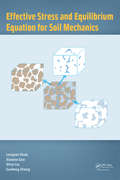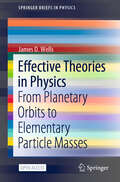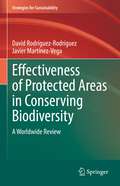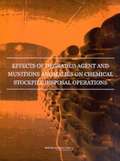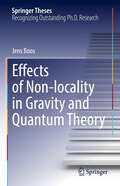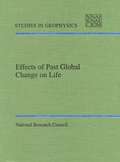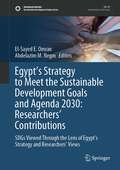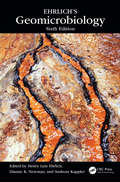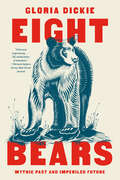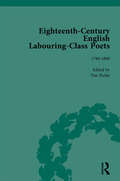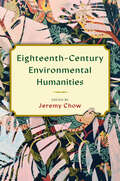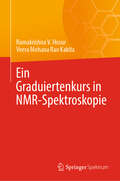- Table View
- List View
Effective Parameters of Hydrogeological Models
by Vikenti GorokhovskiModels of geological objects are tools for interpolation and extrapolation of available data in space and time continuously. Real structures of the objects are unknown, and their models and simulated results carry uncertainty which cannot be evaluated in a provable way. The real issue is obtaining effective predictions in a reasonably defined sense. This requires a knowledge of mechanisms that convert actual geological properties into effective model parameters. These mechanisms are introduced in the book. They reveal that effective parameters are not statistics but characteristics optimizing the system made up by geological surroundings, their models, predictive problem formulations, including mathematical models of the simulated processes, boundary conditions, monitoring networks, criteria of efficiency and even by time. Examples of evaluating and applying transformation for assigning effective parameters and solving inverse problems are presented.
Effective Strategic Sourcing: Drive Performance with Sustainable Strategies for Procurement
by Patrick BarrModern supply chains are enjoying new opportunities for innovation and growth. Build competitive advantage, optimize cost and encourage ethical business practices with the process of strategic sourcing.Effective Strategic Sourcing brings together tools and techniques to develop comprehensive sourcing strategies and drive performance and margin improvement in an ethical, environmentally responsible way. From supplier research and risk analysis to category management and cost modelling, it answers key questions around make versus buy, outsource versus insource and RFI versus RFP.Top supply chain leaders from a range of industries offer their insights and experience in interviews covering the challenges inherent in modern strategic sourcing. The book also focuses on how supply chain and procurement professionals can address sustainability concerns by thinking globally and acting locally and aiming for net-zero carbon footprint sourcing. Learn from the experts and thrive in the 'new normal' with this essential guide to maximising the benefits of strategic sourcing.
Effective Stress and Equilibrium Equation for Soil Mechanics
by Longtan Shao Xiaoxia Guo Shiyi Liu Guofeng ZhengThe concept of effective stress and the effective stress equation is fundamental for establishing the theory of strength and the relationship of stress and strain in soil mechanics and poromechanics. <P><P>However, up till now, the physical meaning of effective stress has not been explained clearly, and the theoretical basis of the effective stress equation has not been proposed. Researchers have not yet reached a common understanding of the feasibility of the concept of effective stress and effective stress equation for unsaturated soils. Effective Stress and Equilibrium Equation for Soil Mechanics discusses the definition of the soil skeleton at first and clarifies that the soil skeleton should include a fraction of pore water. When a free body of soil skeleton is taken to conduct internal force analysis, the stress on the surface of the free body has two parts: one is induced by pore fluid pressure that only includes normal stress; the other is produced by all the other external forces excluding pore fluid pressure. If the effective stress is defined as the soil skeleton stress due to all the external forces excluding pore fluid pressure, the effective stress equation can be easily obtained by the internal force equilibrium analysis. This equation reflects the relationship between the effective stress, total stress and pore fluid pressure, which does not change with the soil property. The effective stress equation of saturated soils and unsaturated soils is unified, i.e., o˜=o˜t –Seuw–(1–Se)ua. For multiphase porous medium, o˜=o˜t –u*,u*=Seiui(i=1,2,...,M). <P><P> In this book, a theoretical formula of the coefficient of permeability for unsaturated soils is derived. The formula of the seepage force is modified based on the equilibrium differential equation of the pore water. The relationship between the effective stress and the shear strength and deformation of unsaturated soils is preliminarily verified. Finally, some possibly controversial problems are discussed to provide a better understanding of the role of the equilibrium equation and the concept of effective stress.
Effective Theories in Physics
by James D. WellsThere is significant interest in the Philosophy of Science community to understand the role that "effective theories" have in the work of forefront science. The ideas of effective theories have been implicit in science for a long time, but have only been articulated well in the last few decades. Since Wilson's renormalization group revolution in the early 1970's, the science community has come to more fully understand its power, and by the mid-1990's it had gained its apotheosis. It is still one of the most powerful concepts in science, which has direct impact in how one thinks about and formulates theories of nature. It is this power that this Brief sets out to emphasize through historical analysis and current examples.
Effective Theories in Physics: From Planetary Orbits to Elementary Particle Masses (SpringerBriefs in Physics)
by James D. WellsThis open access book…There is significant interest in the Philosophy of Science community to understand the role that "effective theories" have in the work of forefront science. The ideas of effective theories have been implicit in science for a long time, but have only been articulated well in the last few decades. Since Wilson's renormalization group revolution in the early 1970's, the science community has come to more fully understand its power, and by the mid-1990's it had gained its apotheosis. It is still one of the most powerful concepts in science, which has direct impact in how one thinks about and formulates theories of nature. It is this power that this Brief sets out to emphasize through historical analysis and current examples.This is an open access book.
Effectiveness of Protected Areas in Conserving Biodiversity: A Worldwide Review (Strategies for Sustainability)
by David Rodríguez-Rodríguez Javier Martínez-VegaThis book addresses the effectiveness of existing protected areas at conserving the diversity of genes, species and ecosystems on land and at sea. The book synthetizes the main biodiversity conservation outcomes of protected areas in the 2010-2019 decade, drawing on a systematic literature review of scientific publications and case studies from around the world demonstrating successes and failures. It provides region-specific results for land and sea ecosystems as well as for developed and developing countries. It also reviews current methodological approaches used to assess protected area effectiveness. The work is timely, since there is growing concern on the global biodiversity crisis among researchers, government organizations and the general public, as demonstrated by the 2030 targets established by the UN Sustainable Development Goals for Life Below Water (SDG 14) and Life On land (SDG15). The book is written in an easy and enjoyable style using numerous pictures, tables and graphs to make the content more engaging and understandable. The main intended audiences of the book are academics, from post-graduate students to university lecturers, and senior researchers in the fields of biodiversity conservation, sustainable development and environmental policy, as well as protected area managers and practitioners.
Effects Of Degraded Agent And Munitions Anomalies On Chemical Stockpile Disposal Operations
by Committee on Review Evaluation of the Army Chemical Stockpile Disposal ProgramThe U.S. Army is in the process of destroying its entire stock of chemical weapons. To help with stockpile disposal, the Army’s Chemical Stockpile Disposal Program (CSDP), in 1987, asked the National Research Council (NRC) for scientific and technical advice. This report is one in a series of such prepared by the NRC over the last 16 years in response to that request. It presents an examination of the effect of leaking munitions (leakers) and other anomalies in the stored stockpile on the operation of the chemical agent disposal facilities. The report presents a discussion of potential causes of these anomalies, leaker tracking and analysis issues, risk implications of anomalies, and recommendations for monitoring and containing these anomalies during the remaining life of the stockpile.
Effects of Non-locality in Gravity and Quantum Theory (Springer Theses)
by Jens BoosThis thesis is devoted to the systematic study of non-local theories that respect Lorentz invariance and are devoid of new, unphysical degrees of freedom. Such theories are attractive for phenomenological applications since they are mostly unconstrained by current experiments. Non-locality has played an increasingly important role in the physics of the last decades, appearing in effective actions in quantum field theory, and arising naturally in string theory and non-commutative geometry. It may even be a necessary ingredient for quantum theories of gravity. It is a feature of quantum entanglement, and may even solve the long-standing black hole information loss problem. “Non-locality” is a broad concept with many promising and fruitful applications in theoretical and mathematical physics. After a historical and pedagogical introduction into the concept of non-locality the author develops the notion of non-local Green functions to study various non-local weak-field problems in quantum mechanics, quantum field theory, gravity, and quantum field theory in curved spacetime. This thesis fills a gap in the literature by providing a self-contained exploration of weak-field effects in non-local theories, thereby establishing a “non-local intuition” which may serve as a stepping stone for studies of the full, non-linear problem of non-locality.
Effects of Past Global Change on Life
by Board on Earth Sciences ResourcesWhat can we expect as global change progresses? Will there be thresholds that trigger sudden shifts in environmental conditions--or that cause catastrophic destruction of life?Effects of Past Global Change on Life explores what earth scientists are learning about the impact of large-scale environmental changes on ancient life--and how these findings may help us resolve today's environmental controversies.Leading authorities discuss historical climate trends and what can be learned from the mass extinctions and other critical periods about the rise and fall of plant and animal species in response to global change. The volume develops a picture of how environmental change has closed some evolutionary doors while opening others--including profound effects on the early members of the human family.An expert panel offers specific recommendations on expanding research and improving investigative tools--and targets historical periods and geological and biological patterns with the most promise of shedding light on future developments.This readable and informative book will be of special interest to professionals in the earth sciences and the environmental community as well as concerned policymakers.
Effects of Trawling and Dredging on Seafloor Habitat
by Committee on Ecosystem Effects of Fishing: Phase 1--Effects of Bottom Trawling on Seafloor HabitatsConcerns over the potential ecological effects of fishing have increased with the expansion of fisheries throughout the marine waters of the United States. Effects of Trawling and Dredging on Seafloor Habitat describes how assessment of fishing impacts depends on gear type, number and location of bottom tows, and the physical and biological characteristics of seafloor habitats. Many experimental studies have documented acute, gear--specific effects of trawling and dredging on various types of habitat. These studies indicate that low mobility, long--lived species are more vulnerable to towed fishing gear than short--lived species in areas where the seabed is often disturbed by natural phenomena. Trawling and dredging may also change the composition and productivity of fish communities dependent on seafloor habitats for food and refuge. The scale of these impacts depends on the level of fishing effort. This volume presents color maps of fishing effort for all regions with significant bottom trawl or dredge fisheries -- the first time that such data has been assembled and analyzed for the entire nation.
Efficient Joint Analysis of Surface Waves and Introduction to Vibration Analysis: Beyond the Clichés
by Giancarlo Dal MoroThis book bridges the gap between theory and practice, showing how a detailed definition of the shear-wave velocity (VS) profile can be efficiently obtained using limited field equipment and following simple acquisition procedures. It demonstrates how surface waves (used to define the VS profile) and vibration data (used to describe the dynamic behaviour of a building) can be recorded using the same equipment, and also highlights common problems, ambiguities and pitfalls that can occur when adopting popular methodologies, which are often based on a series of simplistic assumptions. Today, most national and international building codes take into account a series of parameters aimed at defining the local seismic hazard. Sites are characterised based on the local VS profile, and the dynamic behaviour of existing buildings is defined through the analysis of their eigenmodes. The book includes a series of case studies to help readers gain a deeper understanding of seismic and vibration data and the meaning (pros and cons) of a series of techniques often referred to as MASW, ESAC, SPAC, ReMi, HVSR, MAAM and HS. It also provides access to some of the datasets so that readers can gain a deeper and more concrete understanding of both the theoretical and practical aspects.
Effluent Dye Removal by Microwave-Assisted Activated Carbon (SpringerBriefs in Molecular Science)
by Rehab AbdelghaffarThis book explores the potential of advanced microwave techniques, specifically microwave-assisted pyrolysis, for the production, adsorption, and regeneration of activated carbon (AC) as a promising solution to address wastewater pollution caused by dyes. The author begins with a chapter devoted to the environmental implications of water pollution and emphasizes the characteristics of dyes and various treatment techniques for their removal. The advantages and disadvantages of commercially available activated carbon are also discussed, along with the determinants for effective adsorption using high-quality activated carbon. Additionally, the chapter delves into the different types of adsorbents, including agricultural and industrial waste, as well as bioadsorbents such as microorganisms. In Chapter 2, readers will find the latest trends in using microwave techniques for the activation process. In this chapter, the author elucidates the characteristics and mechanism of microwave heating and compares it with conventional heating methods. The advantages of microwave techniques, such as improved activation procedures and the influence of different factors, are explored. Various modeling and optimization approaches for adsorption and different techniques for analyzing the surface chemistry of activated carbons are also discussed. Furthermore, the chapter showcases the applications of microwave-assisted activated carbon for dye removal. The book closes with a chapter devoted to the recycling and regeneration of spent activated carbon (SAC) using microwave techniques. In this chapter, the author examines the procedures for SAC regeneration through microwave-assisted pyrolysis and highlights the advantages over conventional heating methods. The applications of microwave-assisted activated carbon regeneration and other miscellaneous technologies utilizing microwave heating for AC production and SAC regeneration are also explored. Given its breadth, this book is a valuable resource for researchers, professionals, and policymakers in the field of environmental science and engineering.
Egypt, Greece and Rome Civilizations of the Ancient Mediterranean (2nd Edition)
by Charles FreemanEgypt, Greece and Rome is regarded as one of the best general histories of the ancient world. It is written for the general reader and the student coming to the subject for the first time and provides a reliable and highly accessible point of entry to the period. The volume begins with the early civilizations of Sumer (modern Iraq) and continues through to the Islamic invasions and the birth of modern Europe after the collapse of the western Roman empire. The book ranges beyond political history to cover philosophy, art and literature. A wide range of maps, illustrations and photographs complements the text. The second edition incorporates new chapters on the ancient Mediterranean and the Ancient Near East, as well as extended coverage of Egypt.
Egyptian Coastal Lakes and Wetlands: Characteristics and Hydrodynamics (The Handbook of Environmental Chemistry #71)
by Abdelazim M. Negm Mohamed Ali Bek Sommer Abdel-FattahEgyptian coastal lakes and wetlands are among the most productive wetland ecosystems in the world. This volume explores their current status and how it can be maintained and improved. It describes the five Northern coastal lakes, their origin, physical and chemical properties and current development activities, and discusses the challenges facing these lakes, such as shrinking, pollution, degradation, and adaptive management. Further topics include hydrodynamics and modeling techniques, as well as strategies for the sustainable development of these valuable resources. The book closes with a concise summary of the conclusions and recommendations presented in the chapters. As such, it offers an invaluable resource for the academic community and postgraduate students, as well as for environmental managers and policymakers.
Egyptian Coastal Lakes and Wetlands: Climate Change and Biodiversity (The Handbook of Environmental Chemistry #72)
by Abdelazim M. Negm Mohamed Ali Bek Sommer Abdel-FattahThis volume investigates the challenges facing the Egyptian Northern coastal lakes, focusing on the impact of climate change, their biodiversity and sustainable management. Presenting up-to-date research, it covers the following topics: climate change and water quality modeling and their impacts on the sustainability of the lakes; the economic role of the lakes; the use of remote sensing in monitoring; and the biodiversity of the lakes with detailed discussions. Further, management strategies for the sustainable development of these valuable resources are proposed to maintain the lakes sustainability. The book closes with a concise summary of the conclusions and recommendations presented in the preceding chapters. As such, it offers an invaluable resource for the academic community and postgraduate students, as well as for environmental managers and policymakers.
Egypt’s Strategy to Meet the Sustainable Development Goals and Agenda 2030: SDGs Viewed Through the Lens of Egypt’s Strategy and Researchers' Views (Sustainable Development Goals Series)
by Abdelazim M. Negm El-Sayed E. OmranThis book focuses on Egypt as a representative example of emerging economies struggling to achieve their sustainable development goals (SDGs). The Egyptian government has launched Egypt’s Vision 2030 in line with the 2030 Agenda, also known as the Sustainable Development Strategy (SDS), which encompasses the economic, social and environmental dimensions of development. It is under the SDS that all development plans in Egypt are incorporated while at the same time being strongly guided by the SDGs. Aware of the principle of shared but differentiated responsibility, Egypt also recognizes that fundamental challenges remain, despite a strong willingness to achieve the SDGs. High birth rates, brain drain phenomena, water scarcity, migration, discrimination against women and girls, a growing informal sector and instability in neighboring states (especially Libya and Syria) are only some of the many hindrances to sustainable development.In order to address these challenges, Egypt relies heavily on the SDGs, which are aimed at transforming our world. Although there is an urgent need for a drastic change in the way we use the Earth, the question arises as to whether the SDGs are sufficient to facilitate such a transformation. This book explores the key environmentally related Sustainable Development Goals (SDGs) and offers a cutting-edge assessment of current progress with a view to reaching these objectives by 2030. The book highlights some of the key findings and ideas for how research may help achieve the 17 Sustainable Development Goals in enterprises. The book provides a useful framework that can help and aid the Egyptian government to assess the many goals and targets outlined in the 2030 Agenda. The analysis of Egypt can be used as a blueprint for other developing nations and globally in order to guide policy toward achieving the SDGs. Covering food security, water resilience, climate change, agronomics, rural life, environmental impact assessment as a tool for measuring the achievement of the goals, Egyptian education, the COVID-19 pandemic, cultural and societal dimensions, this book will be of great interest to students and scholars of sustainable development and climate change, as well as practitioners and policymakers involved in sustainable development and disaster management.
Ehrlich's Geomicrobiology
by Henry Lutz EhrlichAdvances in geomicrobiology have progressed at an accelerated pace in recent years. Ehrlich's Geomicrobiology, Sixth Edition surveys various aspects of the field, including the microbial role in elemental cycling and in the formation and degradation of minerals and fossil fuels. Unlike the fifth edition, the sixth includes many expert contributors
Eight Bears: Mythic Past And Imperiled Future
by Gloria DickieA Best Book of the Year in The New Yorker, Economist, and Science News A Scientific American Best Staff Read Shortlisted for the Banff Centre Mountain Book Awards "Vivid and engrossing.… [A] celebration of beardom." —Richard Adams Carey, Wall Street Journal A global exploration of the eight remaining species of bears—and the dangers they face. Bears have always held a central place in our collective memory, from Indigenous folklore and Greek mythology to nineteenth-century fairytales and the modern toy shop. But as humans and bears come into ever-closer contact, our relationship nears a tipping point. Today, most of the eight remaining bear species are threatened with extinction. Some, such as the panda bear and the polar bear, are icons of the natural world; others, such as the spectacled bear and the sloth bear, are far less known. In Eight Bears, journalist Gloria Dickie embarks on a globe-trotting journey to explore each bear’s story, whisking readers from the cloud forests of the Andes to the ice floes of the Arctic; from the jungles of India to the backwoods of the Rocky Mountain West. She meets with key figures on the frontlines of modern conservation efforts—the head of a rescue center for sun and moon bears freed from bile farms, a biologist known as Papa Panda, who has led China’s panda-breeding efforts for almost four decades, a conservationist retraining a military radar system to detect and track polar bears near towns—to reveal the unparalleled challenges bears face as they contend with a rapidly changing climate and encroaching human populations. Weaving together ecology, history, mythology, and a captivating account of her travels and observations, Dickie offers a closer look at our volatile relationship with these magnificent mammals. Engrossing and deeply reported, Eight Bears delivers a clear warning for what we risk losing if we don’t learn to live alongside the animals that have shaped our cultures, geographies, and stories.
Eighteenth-Century English Labouring-Class Poets, vol 3
by John Goodridge Simon Kövesi David Fairer Tim Burke William ChristmasPoets of labouring class origin were published in Britain in the 18th and 19th centuries. Some were popular and important in their day but few are available today. This is a collection of some of those poems from the 18th century.
Eighteenth-Century Environmental Humanities (Transits: Literature, Thought & Culture, 1650-1850)
by Shelby Johnson Jeremy Chow Elliot Patsoura Annette Hulbert Adam Sweeting Mariah Crilley Claire Campbell Jason Payton Matt Duquès Ami Yoon Christopher Allan Black Kate ScarthThis groundbreaking new volume unites eighteenth-century studies and the environmental humanities, showcasing how these fields can vibrantly benefit one another. In eleven chapters that engage a variety of eighteenth-century texts, contributors explore timely themes and topics such as climate change, new materialisms, the blue humanities, indigeneity and decoloniality, and green utopianism. Additionally, each chapter reflects on pedagogical concerns, asking: How do we teach eighteenth-century environmental humanities? With particular attention to the voices of early-career scholars who bring cutting-edge perspectives, these essays highlight vital and innovative trends that can enrich both disciplines, making them essential for classroom use.
Ein Graduiertenkurs in NMR-Spektroskopie
by Ramakrishna V. Hosur Veera Mohana KakitaDieses Lehrbuch richtet sich an Graduierte und führt in die grundlegenden Konzepte der Kernmagnetischen Resonanzspektroskopie (NMR), der spektralen Analyse und moderner Entwicklungen wie der mehrdimensionalen NMR ein, und zwar in angemessener Tiefe und Strenge. Das Buch ist in sich geschlossen und daher in diesem Sinne einzigartig, mit am Ende der Kapitel enthaltenen Übungen, unterstützt durch eine Lösungsanleitung. Einige fortgeschrittene Themen sind als Anhänge für schnelles Nachschlagen enthalten. Studierende der Chemie, die bereits einige Kenntnisse in Mathematik und Physik haben, profitieren von diesem Buch und werden darauf vorbereitet, Forschung in verschiedenen Bereichen der Chemie, Biophysik oder Strukturbiologie zu betreiben.
Ein Weltrat für den Umweltschutz: Unser Planet ist noch zu retten! (essentials)
by Christoph J. RohlandDieses Essential ist ein Aufruf an alle, die sich für den globalen Umweltschutz einsetzen wollen. Die Klimakrise ist seit Jahrzehnten länderübergreifend und nimmt auf allen Kontinenten stark zu. Es ist Zeit, dass ein geopolitischer exekutiver Weltrat für Umweltschutz (WRFU) und ein legislatives Weltparlament für Umweltschutz (WPFU) die internationale Verantwortung übernehmen. Das weltweite Ziel heisst: Klimagerechtigkeit mit Null Treibhausgas-Emissionen und hundert Prozent recyclebaren Ressourcen.
Ein neuer Gesellschaftsvertrag für eine nachhaltige Landwirtschaft: Wege zu einer integrativen Politik für den Agrarsektor
by Claudia Pahl-Wostl Christine Krämer Volkmar Wolters Kai P. Purnhagen Peter H. Feindt Andrea Früh-Müller Alois Heißenhuber Fabian Thomas Caroline van BersDie Landwirtschaft in Deutschland, Europa und weltweit befindet sich in einem dramatischen Umbruchprozess. Einerseits bieten Liberalisierung und Marktöffnung, neue technologische Entwicklungen, die wachsende Weltbevölkerung und neue Kundenwünsche vielen landwirtschaftlichen Betrieben neue Möglichkeiten. Andererseits stehen viele Landwirtinnen und Landwirte in internationaler Konkurrenz, sind zum betrieblichen Wachstum mit hohem Investitionsrisiko gezwungen, sind Teil strikt regulierter Wertschöpfungsketten und müssen steigenden gesellschaftlichen Ansprüchen genügen. Zugleich machen sich viele Menschen Sorgen, dass die Prozesse der Rationalisierung und Modernisierung der landwirtschaftlichen Produktion auf Kosten von Natur-, Umwelt- und Tierschutz gehen. Auf vielen Ebenen wird daher bereits nach einer neuen Verständigung darüber gesucht, was die Gesellschaft von der Landwirtschaft erwartet, und welche Unterstützung die Landwirtinnen und Landwirte im Gegenzug dafür erwarten dürfen. Vor diesem Hintergrund entwickelt das vorliegende Open Access-Buch eine wissenschaftlich fundierte Kritik der Umweltauswirkungen der Landwirtschaft und der politischen Logik der Agrarpolitik. Es präsentiert ein neues Leitbild mit konkreten Indikatoren sowie alternative strategische Handlungsoptionen. Die umfassende Analyse wird zu einem Vorschlag für eine neue Architektur der europäischen Agrarpolitik gebündelt, die eine breite Diskussion um einen Neuen Gesellschaftsvertrag für die Landwirtschaft in Deutschland und Europa anstoßen soll.
Einblicke in die euklidische und nichteuklidische Geometrie
by Jürgen WagnerDieses Buch thematisiert wesentliche Grundlagen der euklidischen Geometrie sowie mehrerer nichteuklidischer Geometrien und unterstützt damit Studierende der Mathematik, Physik, Astronomie, Geografie, Geodäsie und Nautik. Von den vielfältigen Bezügen zwischen ausgewählten Inhalten der euklidischen Geometrie, Taxi-Geometrie, projektiven, sphärischen und hyperbolischen Geometrie profitieren auch Studierende des Lehramtes Mathematik. Es erleichtert insbesondere die Einarbeitung in Fragestellungen der synthetischen Geometrie, speziellen und allgemeinen Relativitätstheorie, Astrometrie, Kartenentwürfe und Navigation.Kennzeichnende Merkmale dieses Buches sind seine Anbindung an schulische Vorkenntnisse sowie die Verdeutlichung von Begriffsbildungen und Vorgehensweisen durch verständnisfördernde Hintergrundinformationen, viele Abbildungen, ausführlich vorgerechnete Beispiele und detailliert beschriebene Konstruktionen. Wegen dieser didaktischen Konzeption eignet sich das Buch hervorragend zur Begleitung der Lehrveranstaltungen an der Hochschule, indem es die übliche algebraische Darstellung auf hohem Abstraktionsniveau „mit Leben erfüllt“ und verständlich macht. Die Besonderheit des Buches liegt darin, dass der Autor den Mut aufgebracht hat, auf einen vollständigen synthetischen Aufbau der angesprochenen Geometrien zugunsten von Querverbindungen zwischen ihnen zu verzichten. Um den Rahmen des Buches nicht zu sprengen und die Übersicht zu wahren, werden Beweise dann geführt, wenn es sich um zentrale Sätze handelt oder wenn typische Vorgehensweisen verdeutlicht werden können.
Eine Einführung in gewöhnliche Differentialgleichungen: Analytische und numerische Methoden
by Martin Hermann Masoud SaraviDieses Buch bietet eine moderne Einführung in analytische und numerische Verfahren zur Lösung gewöhnlicher Differentialgleichungen (DGLn). Im Gegensatz zum traditionellen Format - dem Theorem-und-Beweis-Format - konzentriert sich das Buch auf konstruktive analytische und numerische Methoden. Das Buch liefert eine Vielzahl von Problemen und Beispielen, die von der elementaren bis zur fortgeschrittenen Ebene reichen, um die Mathematik von DGLn einzuführen und zu studieren. Der analytische Teil des Buches befasst sich mit Lösungstechniken für skalare lineare DGLn erster und zweiter Ordnung sowie für Systeme linearer DGLn - mit besonderem Augenmerk auf die Laplace-Transformation, Operatortechniken und Potenzreihenlösungen. Im numerischen Teil werden theoretische und praktische Aspekte von Runge-Kutta-Methoden zur Lösung von Anfangswertproblemen und Schießverfahren für lineare Zweipunkt-Randwertprobleme betrachtet.Das Buch ist als Grundlagentext für Kurse über die Theorie von DGLn und die numerische Behandlung von DGLn für fortgeschrittene Studenten im Grundstudium und für Studenten im Anfangsstadium ihres Studiums gedacht. Es wird vorausgesetzt, dass der Leser über Grundkenntnisse der elementaren mathematischen Analysis, insbesondere der Integrationsmethoden, und der numerischen Mathematik verfügt. Physiker, Chemiker, Biologen, Informatiker und Ingenieure, die mit der Lösung von DGLn zu tun haben, werden das Buch auch als Nachschlagewerk und Hilfsmittel für das Selbststudium nützlich finden. Das Buch wurde im Rahmen eines deutsch-iranischen Forschungsprojekts zu mathematischen Methoden für DGLn erstellt, das Anfang 2012 begonnen wurde.


